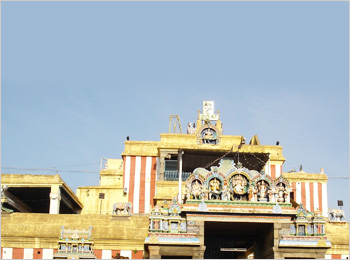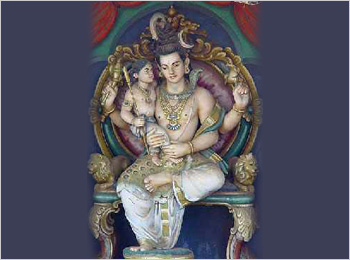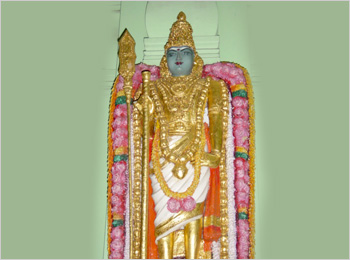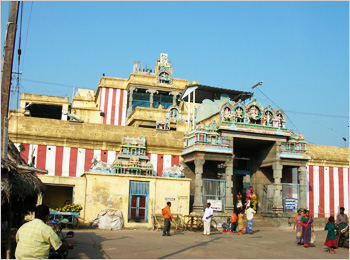- Murugan
Swaminathaswami Temple
- Swamimalai,Tamil Nadu
- View on map
- Tell us about this temple
Overview
Swamimalai is the fourth of the Arupadai veedu or consecrated temples dedicated to God Muruga. Here, God Muruga explained the importance of the Pranava mantra OM to his Father God Siva. Swamimalai is located around five kilometers west of Kumbakonam on the banks of a tributary of stream Cauvery. Thiruverakam, prevalently known as 'Swamimalai' is situated at a separation eight kilometers from Kumbakonam in Thanjavur locale on the northern banks of the waterway Cauvery. It is one of the six renowned dwelling places devoted to God Muruga (additionally spelt Murugan).
About the Temple

The temple is found on a hill of around sixty feet in height. It has sixty stone steps. In the ground floor there are temples devoted to God Sundareswarer and Goddess Meenakshi. Praises for the deity and the temple were sung by Nakkeerar in Tirumurukatrupadai and by Saint Arunagirnathar in Tiruppukazh. The temple has a brilliant chariot made of seven kilos of gold, 85 kilos of silver and different metals like copper, wonderfully enlightened with electric knobs. Among the sub-temples under the Swamimalai temple, the Sveta Vinayagar temple at Tiruvalanchuli is important. Praises of Sadaimudinathar and Goddess Perianayaki have been sung by Tirugnanasambandar and Tirunavukkarasar in Tevaram.
The holy Cauvery River is found in a half circle around this sanctum and thus the name Valanchuli or right winds. The temple has three 'Gopurams' with three 'Praharams'. The 'Gopuram' on the south side of the temple is enlivened with statues and contains five stories while the other two passages have no towers above them. The Praharam (additionally spelt as Prahar) is impossible to miss in this temple. The primary Praharam is at the base, the second most of the way up the slope and the third at the top, encompassing the sanctum. On passing the 'Raja Gopuram' and the 'KalyanaMandapam' one sees the holy place dedicated to Goddess Sakti at the base. Steps lead from here upwards towards the highest point of the slope.
Other Temples

Among the sub-temples under the organization of the Swamimalai temple, the Sveta Vinayagar temple at Tiruvalanchuli is significant. The managing divinity God Sadaimudinathar and Goddess Perianayaki have been sung by Tirugnanasambandar and Tirunavukkarasar in Tevaram. Another architecturally beautiful temple at Kilpazhayarai dedicated to Lord Somanathaswami is also under renovation at an estimated cost of Rs. 50 Lakhs. It is worth mentioning that this shrine is the birthplace of Saint Managaiyarkarasi, one among the 63 Nayanmars. Hymns in praise of the presiding deity have been sung by Tirunavukkarasar. Other temples mentioned below under the administrative control of Swamimalai temple are also to be renovated at a modest cost of about Rs. 5 lakhs each.
1. Dharmapureeswarar Temple, Vallalarkoil
2. Chakravageeswarar Temple, Chakkrapalli
3. Ezhutharinathar Temple, Innambur
4. Skandanathar Temple, Tiruerakaram
5. Thirupandeeswarar Temple, Adanur
About the Deity

The Tamil word Murugu implies all energy and comeliness. Evidently that God Muruga is comeliness represented. He is a pioneer in the Vibuti abishek. God Muruga shows up as the Bana of a Shivalinga and the peeta as the Avudayar. This is to stress reality that God Muruga and God Shiva are not unique in relation to one another, but are rather one. The God here presents Himself as Gurunatha who taught the substance of Pranava to His Father, Shiva ('Swami') and along these lines got to be Swaminatha.
Legend and Stories
According to legend, Brahma, the Hindu divine force of creation, affronted Muruga (the child of Shiva) at the time of going by Mount Kailash, the home of Shiva. The kid Muruga got irate with Brahma and asked him how he was making living creatures. Brahma said that he was making living creatures with the assistance of the Vedas (Hindu sacred writings). On listening to the answer, Muruga requested that Brahma recount the writings from Vedas. Brahma began to recount the content with the blessed word called Pranav Mantra, ''Om''. Around then Muruga ceased Brahma and solicited him to clarify the significance from the Pranava Mantra. Brahma couldn't answer and consequently Muruga thumped Brahma on his temple with his gripped clench hands and rebuffed him with detainment. Muruga took up the inventor's part.
The Devas (divine gods) were astonished by the nonattendance of Brahma and they asked Vishnu to convince Muruga to discharge Brahma. Vishnu couldn't help and if all else fails, Shiva went to the salvage of Brahma. Shiva came to Muruga and requesting that he discharge Brahma from detainment. Muruga declined to discharge him expressing Brahma was ignorant of the significance of the Pranav Mantra. Shiva requested that Muruga clarify the importance and Muruga praised to Shiva the significance of the Pranava Mantra. Shiva acted like an understudy to an educator, listening with riveted consideration from his child, giving Muruga the name ''Swaminatha Swami''. The significance of this name is 'The Teacher of Shiva'.
Another legend has it that Saint Bhrugu before starting a strenuous tapas or atonement, got the aid that anyone aggravating his intercession will overlook all his insight. Such was the repentance's force that the consecrated flame exuding from the saint’s leader came to up to the sky, and the scared devas surrendered to God Siva appealing to God for his effortlessness. The God quenched the hallowed flame by covering the holy person's head by hand. With the holy person's repentance hence exasperates the God got to be neglectful of all his insight and is said to have recaptured them by taking in the Pranava mantra from God Muruga at this hallowed place. Once when Brahma, the God of all manifestations was continuing to Kailasa, the ever-perky tyke God Muruga approached him for the importance of the Pranava OM.
At the point when Brahma conceded his obliviousness, the God detained him. With Brahma detained, all manifestations ground to a halt and the devas appealed to God Siva to get Brahma discharged. At the point when Muruga demanded that the detainment was an only discipline for the obliviousness of Brahma, God Siva asked him whether he himself knew the importance of the primordial Pranava OM. God Muruga said that he knew the significance of OM and can elucidate it to the recent just on the off chance that he can acknowledge him as master and listen to the work as a gave follower. As God Siva agreed to the solicitation of God Muruga and heard the piece of OM as he taught, the spot came to be known as Swamimalai and the managing god as Swaminathan.
History
The temple of Swaminatha is extremely old one and it is known not existed even in the 2nd century BC. It is said that Parantaka Chola I manufactured the temple. The temple was harmed, all things considered, and the Gopurams were crushed and demolished to ground in the year 1740 when the Anglo-French War was pursued later when war broke out between Hyder Ali and the British. Swamimalai is fourth among the six padai veedu or sacrosanct hallowed places committed to God Muruga.
Festivals
The temple has gold, jewels, diamonds, and rubies, silver vessel and other costly articles worth many lakhs of rupees. Every Thursday, Lord Swaminathan is decorated with Diamond Vel. The day of Krittika is very important and thousands of people worship the Lord every month on this day. The main festivals are the Brahma Utsavam, Skanda Shashti and the festival of Subrahmanya's marriage with Valli. A popular event performed a few years ago is the Sri Subrahmanya Sahasranama (1008 names of Subrahmanya) Archana. A Sahasra namamala, a garland of gold coins on each of which one of the 1,008 names of the Lord was inscribed, was made and offered to the deity. Devotees from far and near in large numbers participated in this holy and pious act. Here also pilgrims carry Kavadis to the shrine and abhishekams are performed to the idol on behalf of the devotees. Bathing of the deity in holy ashes, known as “Vibhuti Abhishekam” is a feature here as in palani temple, and in that Abhishekam the idol has a very captivating and awe-inspiring aspect.
Important festivals
Monthly Kirutikai Festival
Krithigai is an important festival celebrated in the Tamil month of Adi or Aadi. The festival is dedicated to Lord Muruga or Subrahamaniya. Incidentally, the festival is also referred as Aadi Krittika, Kirthigai, Kritika and Krithika. The festival is celebrated with fervour in the Murugan Temples in Tamil Nadu. Krithigai in some regions is celebrated to symbolise the victory of good over evil, when Murugan slew the demon Surapadma. After the annihilation of the demon, Muruga blessed devotees with boons.
Vaikasi Visagam (May – June)Many devotees participate in the festival. A procession of Sri Jayanthinathar with Valli and Deivanai is conducted in the night.
Avani Festival (August – September)Devotees numbering about two lakh participate in this festival. On this Avani festival 7th, 8th and 10th day functions are more important. On the 7th, the Sikappu sathi Festival takes place. On 8th, it is the Pachai Sathi Festival and on 10th, there is a Car Festival.
Skanda Sasti Festival - 7 days (October – November)Devotees numbering about five lakhs will participate in the above festival. On this festival occasion, devotees fast for all six days. On the 6th day Surasamharam is demonstrated. On the 7th day Thirukkalyanam to Deivanai is celebrated in a grand manner.
Masi Festival - 12 days (February – March)More than three lakh people participate in this festival. On the 7th, the Sikappu sathi Festival takes place. On 8th, it is the Pachai Sathi Festival and on 10th, there is a Car Festival. On the 11th day, a floating festival takes place.
Pooja Timings
Day by day pujas to the divinities are performed six times each day (six kalams). Usha Kalam, Kalasandhi and Uchikala poojas are performed in the forenoon and the evening poojas starting from Sayaratchai and Rendam kalam are finished up with Arthajama pooja in the night.
|
Pooja |
Timing |
|---|---|
|
Usha Kalam |
06:00 A.M |
|
Kalasandhi |
09:00 A.M |
|
Uchikala Poojas |
12:00 Noon |
|
Sayaratchai |
05:30 P.M |
|
Rendam kalam |
08:00 P.M |
|
Arthajama pooja |
10:00 P.M |
Pooja / Seva
|
Item |
Price |
|---|---|
|
Archanai |
Rs.5 |
|
Kavadi chindu |
Rs.50 |
|
Tonsure |
Rs.10 |
|
Kalayana Kanekai |
Rs.300 |
|
Abishekam |
Rs.1500 |
|
Special Entrance |
Rs.50 |
|
Sahasranaamam Archanai |
Rs.100 |
|
Golden Chariot |
Rs.1201 |
|
Metal kanekai |
Rs.10 |
|
Ear Boring |
Rs.50 |
Vows and Offerings
Devotees who take a vow place their offerings during festival and other days.Tonsuring in the temple, abishek with sandal, panchamirtha (a mixture of five ingredients), milk are performed by devotees.They fast and carry Kavadi, Palkudam, offer Abishegam etc. to the Lord. Feeding is undertaken by some. Devotees light ghee lamps.The Golden Chariot procession, Chandana Lebanam, Dharabhishegam, Dharahomam are performed by devotees in fulfilment of their vows.Those facing enemy troubles perform Thirisada archana. The rich offer liberal contributions for the maintenance and renovation of the temple. Devotees who perform such austerities get relieved of their mental worries; the unmarried get married; and the childless beget children by the grace of the Lord.
Facilities
For the convenience of the pilgrims and devotees, 11 rooms, four cottages, two VIP cottages, one donor cottages, three marriage halls and one dining hall have been constructed and are let out at nominal rent ranging from Rs. 20/- to Rs. 100/- per day.
Rare Facts
A special component of this temple is the Sveta Vinayagar or White Pillaiyar made of the ocean froth shaped at the season of beating of the Milky Ocean by the devas and asuras to get the nectar.
Nearby Places to visit
Dharasuram
It is located 4 km to the west of Kumbakonam, was built by the Chola King, Rajaraja II. This temple is dedicated to Shiva, who is Airavateshvara, the “Lord of Airavata”. Legend claims that after Airavata, the white elephant of Indhra, the God of the Heavens, regained his lost colour, he worshipped Shiva at this spot. The four-tiered temple has a Sanctum and three halls, of which the finest is the Raja-Gambira Mandapa conceived as a stone chariot drawn by caparisoned horses with Brahma as its driver. The outer walls have fine friezes and carvings of musicians, dancers and acrobats as well as depictions from the Periya Puranam, a Tamil treatise on 63 Shaivite poet-saints, the Nayannars.
Tirubhuvanam
It is located 8 km (5 miles) Northeast of Kumbakonam, is dedicated to Kumbheswara, the “God who removes Fear”. This is also an old silk weaving centre. Kambaharesvarar Temple was built by the King Kulothunga III (1179 AD - 1216 AD). There are two Gopurams and two Praharams,the Karpagraham, Artha Mandapam, Maha Mandapam, Muha Mandapam and Somaskandar Mandapam.The Karpagraham is in the shape of square. It's both sides are having Karnathuvara steps. Dhakshinamoorthy, Lingothbhavar and Bramma reside on the wall of Sri Vimana.There are six base of Srivimana. One can see sculptures of the scenes of Puranas on the wall of Srivimana. Some of other shrines are in the temple. It is the 13th century Chola temple dedicated to Lord Shiva.
Gangaikonda Cholapuram
It is one of the very ancient temples of Tamil Nadu, built in the Chola style. Gangai Konda Chola Puram, “The City of the Chola who took the Ganges”, was the capital of powerful Chola dynasty during the reign of Rajendra I. Rajendra I, was the first Tamil ruler to venture Northwards and a great military commander like his father Rajaraja I. He built this city to commemorate his successful campaign across the Ganges.
Brihadishwara Temple
It is 35 km North of Kumbakonam. It was built by the Chola emperor Rajendra I. Later additions were made in the 15th century by the Nayaks. It was built as a replica of Thanjavur’s Brihadishvara temple by his father Rajaraja I, the towered sanctum of this granite Shiva temple is shorter than the one at Thanjavur. It is indeed a great feat of engineering. All the more as the construction, was done in such a way that the shadow of the cupola never falls on the ground.The sanctum sanctorum has a four meter high lingam with a circumference of 7 meters. The inner walls of the temple have the many mudras (poses) of Bharatnatyam (classical Indian dance) portrayed by dancing damsels. Perhaps the sculptors did this as Shiva, the presiding deity is also the God of Dance (Natraja).
Tranquebar (Tharangambadi)
About 80 km south of Chidambaram, Tranquebar was a Danish post, established 1620. The seafront Danesborg Fort was occupied by the British in 1801. It houses a small but fascinating Museum on aspects of Danish history here. It takes 2 ½ hours from Chidambaram to reach this place. There is no accommodation here.
Calimere Wildlife & Bird Temple
This 333 sq km temple also known locally as Kodikkarai, 90 km southeast of Thanjavur.It is noted for its vast flocks of migratory waterfowl, Calimere’s tidal mud flats are home to teals, shovellers, curlews, gulls, terns, plovers, sandpipers, shanks and herons from November to January. The easiest way to get to Calimere is from Vedaranniyam, 12 km away and the nearest town linked by frequent buses to Nagapattinam or Thanjavur.
Thanjavur Palace Devasthanam
Located at a distance of 1 km from Thanjavur Junction in Southern Railways is connected by both Meter Gauge and Broad Gauge sections. The town is also well connected by bus routes from important towns in South India .The temple is repository of Art and Culture and is an architectural marvel. The shrine of Goddess Varahi in the Southern Praharam and Saint Karuvoorar Shrine in Western Praharam are very famous. The monument is maintained by Archaeological Survey of India while the temple administration is by Thanjavur Palace Devasthanam under the control of H.R & C.E Administration Department, Tamil Nadu.
Arulmigu Oppliappan Swamy Temple
Lord Vishnu-Perumal came to Sage Markandeya on a Panguni (March-April) Tiruvonam star day seeking his daughter’s hand in marriage. The wedding took place on Aipasi (October-November) Tiruvonam Star day. Remembering this event, on Tiruvonam Star day each month, special pujas are performed with Aganda Deepa (big deepa) and Long deepa – Vaal deepa lighting. It is believed that Mother Mahalakshmi graces devotees from these lamps. This darshan is considered a lucky one by the devotees.On Aavani Tiruvonam star day, Perumal grants darshan Udaya Garuda Sevai. Then He bathes in the Nattaru River praised as Dakshina Ganga. Special pujas are performed after this event.
Arulmigu Garbaratchambigai Temple
Sri Garbarakshambigai Amman temple is situated in Thirukarukavur (Thirukkarugavur), a small village in Thanjavur district, Tamil Nadu, South India. This is an ancient temple of God Shiva dedicated to Sri Mullaivananathar and Sri Garbarakshambigai Amman. Appar, Sundarar and Sambandhar, the three famous Nayanmaars have celebrated the glory of this temple in soul stirring verses. The remarkable feature which distinguishes this temple from the other shrines is that, Goddess Sri Garbarakshambigai Amman here cures infertility related problems to women, blesses them to conceive and also helps them for safe and trouble free delivery. Sri Mullaivananathar swamy is worshipped for better health and well being.
Arulmigu Thiyagaraja Swamy Temple, Tiruvarur
The Thiyagaraja temple at Thiruvarur is one of the ancient heritage sites of India and is a representation of the religio-socio-cultural history of the Tamil region for a period spanning over a millennium and a half. Little is known about this shrine to much of India.Located near Thanjavur in Tamilnadu, Thiruvarur is an ancient shrine steeped in mysticism. It is rich in legend, history and tradition.
Accessibility
Airport
The nearest airport is the Trichy airport from the temple, at about 81.5 kilometres.
Railways
The nearest Railway Stations are Kumbakonam Railway Station (8.9 kms) Thanjavur Railway Station (40.1 kms) and the Trichy Railway Station (77.6 kms).
Road
one can take a bus at the Kumbakonam Bus Stand (8.7 kms), the Thanjavur old Bus stand from temple (34.8 kms) and the Trichy Bus stand from temple (79.2 kms).
Temple Address
Arulmigu Swaminatha Swami Temple,
Thirumanjana Veedhi, Swamimalai,
Thanjavur, Tamilnadu, India,
Pincode – 612302.
Significance
Devotees visit this temple to seek fulfillment of the following:-
- Solution for problems
- Happy married life
- Child boon
- Family prosperity
- Longevity
- Education
Shlokas
Shadaananam Chandana Liptha Gathram Mahorasam Divya Mayoora Vaahanam Rudrasya Soonum Suraloka Naatham Brahmanya Devam Charanam Prapadye
Meaning -I always take refuge in the 6 faced Lord Guha, who has sandal paste smeared over his body, who is broad-chested, whose vehicle is the peacock, who is Lord Shiva's son and who leads the army of the Devas.
Heyswami Natha Karunakara Dheenabandho Shree Parvatheesha Mukha Pankaja Padmabandho Shree Saadhi Devagana Poojitha Padha Padma Vallesa Nadha Mama Dehi Karaavalambham
Meaning -O! Merciful Lord Swaminatha, who cares for the poor, who is the sun to Lord Shiva's lotus face, whose lotus feet are acknowledged by Lord Vishnu and the others, Valli's Lord, please uplift me by lending me your hand.
Ariru Thadanthozh Vazhga Arumugam Vazhga Veppai Kooru Sei Thanivel Vazhga Kukkudum Vazhga Sevvel Yeriya Magnai Vazhga Aanai Thun Anangu Vazhga Maarila Valli Vazhga Vazhga Seer Adiyar Yellam
Meaning -Oh Muruga, we hail your 12 strong shoulders for they protect us from our enemies, we hail your 6 faces, we hail the Vel, your weapon that broke apart the Krounja mountain to reveal the asura in it. We hail the bird, the cock, that is part of your symbol in the flag. We hail your peacock, that takes you all over the world, we hail your consort Devyani, who was brought up by Indra's white elephant, Airavadam, we hail your other consort, the flawless Valli. And we hail your Bhaktas who worship you as a prayer.
Uruvai Aruvai Uladhai Iladhai Maruvai Malarai Maniyai Oliyai Karuvai Uyirai Gadhiyai Vidhiyai Guruvai Varuvai Arulvai Guhaney
Meaning -O Lord Muruga, you have form and you are formless, you have everything and have nothing, you who exist in the smallest, in flowers, in a bell's ring, in the light. You are the embryo, the life, destiny and fate. Bestow your blessings on us as our guru.
Timings
This temple is open from 5:00 am to 12:00 pm and 4:00 pm to 10:00 pm.
